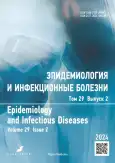Случаи легионеллёза в Краснодарском крае в период пандемии новой коронавирусной инфекции COVID-19: трудности диагностики
- Авторы: Авдеева М.Г.1, Блажняя Л.П.1, Мошкова Д.Ю.1, Кулбужева М.И.1,2, Савицкая И.М.2, Подсадняя А.А.1,2, Кириленко Н.А.1,2, Яковчук Е.Е.2, Чернявская О.В.2, Мамонова П.О.2
-
Учреждения:
- Кубанский государственный медицинский университет
- Специализированная клиническая инфекционная больница
- Выпуск: Том 29, № 2 (2024)
- Страницы: 151-164
- Раздел: КЛИНИЧЕСКИЕ СЛУЧАИ
- URL: https://ogarev-online.ru/1560-9529/article/view/257365
- DOI: https://doi.org/10.17816/EID627123
- ID: 257365
Цитировать
Аннотация
Высокая заболеваемость внебольничными пневмониями на фоне сохраняющейся регистрации COVID-19 требует проведения ранней дифференциальной диагностики ввиду различной тактики ведения пациентов. Среди внебольничных пневмоний особого внимания заслуживают заболевания легионеллёзной природы. Сложность клинической диагностики легионеллёза в период пандемии COVID-19 ведёт к несвоевременному назначению специфической антибактериальной терапии, что ухудшает прогноз исхода заболевания. В работе приведены клинические примеры, обращающие внимание специалистов на особенности клинико-лабораторных и рентгенологических проявлений легионеллёза, а также на важную роль эпидемиологических данных для дифференциальной диагностики легионеллёза с новой коронавирусной инфекцией COVID-19.
Особенностью описанных клинических случаев является: поздняя диагностика с госпитализацией на 7–10-й день болезни у пациентов, имеющих повышенный индекс массы тела; тяжёлое течение двусторонней полисегментарной пневмонии с формированием полости и многорядных булл в лёгких; наличие протеинурии, повышение уровня мочевины и/или креатинина, лимфопения. Во всех случаях отмечено нахождение в кондиционируемых помещениях, в том числе поездка в поезде. При КТ-диагностике описана нетипичная для COVID-19 локализация процесса, манифестация с участков консолидации с симптомом воздушной бронхографии, наличие плеврального выпота, несоответствие интенсивности изменений дню заболевания и тяжести состояния пациента.
Для специфической диагностики легионеллёза тестирование на Legionella spp. с определением легионеллёзного антигена в моче рекомендуется проводить при поступлении в стационар всем пациентам с тяжёлой внебольничной пневмонией.
Ключевые слова
Полный текст
Открыть статью на сайте журналаОб авторах
Марина Геннадьевна Авдеева
Кубанский государственный медицинский университет
Автор, ответственный за переписку.
Email: avdeevam@mail.ru
ORCID iD: 0000-0002-4979-8768
SPIN-код: 2066-2690
д-р мед. наук, профессор
Россия, КраснодарЛюдмила Павловна Блажняя
Кубанский государственный медицинский университет
Email: p-blazhnyaya@mail.ru
ORCID iD: 0000-0002-0055-1764
SPIN-код: 1164-7038
канд. мед. наук, доцент
Россия, КраснодарДарья Юрьевна Мошкова
Кубанский государственный медицинский университет
Email: Mrs_darya@mail.ru
ORCID iD: 0000-0003-1401-6970
SPIN-код: 9489-0057
канд. мед. наук, доцент
Россия, КраснодарМакка Ибрагимовна Кулбужева
Кубанский государственный медицинский университет; Специализированная клиническая инфекционная больница
Email: kulbuzhevamakka@yandex.ru
ORCID iD: 0000-0003-1817-6664
SPIN-код: 8090-3715
канд. мед. наук, доцент
Россия, Краснодар; КраснодарИлина Михайловна Савицкая
Специализированная клиническая инфекционная больница
Email: avdeevam@mail.ru
ORCID iD: 0009-0004-5818-5287
Россия, Краснодар
Ангелина Александровна Подсадняя
Кубанский государственный медицинский университет; Специализированная клиническая инфекционная больница
Email: avdeevam@mail.ru
ORCID iD: 0009-0009-5225-9296
SPIN-код: 8490-1523
Россия, Краснодар; Краснодар
Наталья Алексеевна Кириленко
Кубанский государственный медицинский университет; Специализированная клиническая инфекционная больница
Email: nafany-78@mail.ru
ORCID iD: 0000-0003-2302-6214
Россия, Краснодар; Краснодар
Елена Евгеньевна Яковчук
Специализированная клиническая инфекционная больница
Email: elena-yakovchuk@yandex.ru
ORCID iD: 0009-0001-9690-7285
Россия, Краснодар
Оксана Викторовна Чернявская
Специализированная клиническая инфекционная больница
Email: kdlskib@mail.ru
ORCID iD: 0009-0007-8032-3537
Россия, Краснодар
Полина Олеговна Мамонова
Специализированная клиническая инфекционная больница
Email: polinadoncova@yandex.ru
ORCID iD: 0009-0002-6945-7263
Россия, Краснодар
Список литературы
- Cattan S., Thizy G., Michon A., et al. Actualités sur les infections à Legionella // Rev Med Interne. 2019. Vol. 40, N 12. P. 791–798. doi: 10.1016/j.revmed.2019.08.007
- Graham F.F., Hales S., White P.S., Baker M.G. Review Global seroprevalence of legionellosis — a systematic review and meta-analysis // Sci Rep. 2020. Vol. 10, N 1. P. 7337. doi: 10.1038/s41598-020-63740-y
- Chauhan D., Shames S.R. Pathogenicity and Virulence of Legionella: Intracellular replication and host response // Virulence. 2021. Vol. 12, N 1. P. 1122–1144. doi: 10.1080/21505594.2021.1903199
- Kim S., Isberg R.R. The Sde phosphoribosyl-linked ubiquitin transferases protect the Legionella pneumophila vacuole from degradation by the host // Proc Natl Acad Sci U S A. 2023. Vol. 120, N 33. P. e2303942120. doi: 10.1073/pnas.2303942120
- Shames S.R. Eat or Be Eaten: Strategies Used by Legionella to Acquire Host-Derived Nutrients and Evade Lysosomal Degradation // Infect Immun. 2023. Vol. 91, N 4. P. e0044122. doi: 10.1128/iai.00441-22
- Böck D., Hüsler D., Steiner B., et al. The Polar Legionella Icm/Dot T4SS Establishes Distinct Contact Sites with the Pathogen Vacuole Membrane // mBio. 2021. Vol. 12, N 5. P. e0218021. doi: 10.1128/mbio.02180-21
- Tomaskovic I., Gonzalez A., Dikic I. Ubiquitin and Legionella: From bench to bedside // Semin Cell Dev Biol. 2022. Vol. 132. P. 230–241. doi: 10.1016/j.semcdb.2022.02.008
- Park B., Park G., Kim J., Lim S.A., Lee K.M. Innate immunity against Legionella pneumophila during pulmonary infections in mice // Arch Pharm Res. 2017. Vol. 40, N 2. P. 131–145. doi: 10.1007/s12272-016-0859-9
- Chahin A., Opal S.M. Severe Pneumonia Caused by Legionella pneumophila: Differential Diagnosis and Therapeutic Considerations // Infect Dis Clin North Am. 2017. Vol. 31, N 1. P. 111–121. doi: 10.1016/j.idc.2016.10.009
- Viasus D., Gaia V., Manzur-Barbur C., Carratalà J. Legionnaires’ Disease: Update on Diagnosis and Treatment // Infect Dis Ther. 2022. Vol. 11, N 3. P. 973–986. doi: 10.1007/s40121-022-00635-7
Дополнительные файлы















